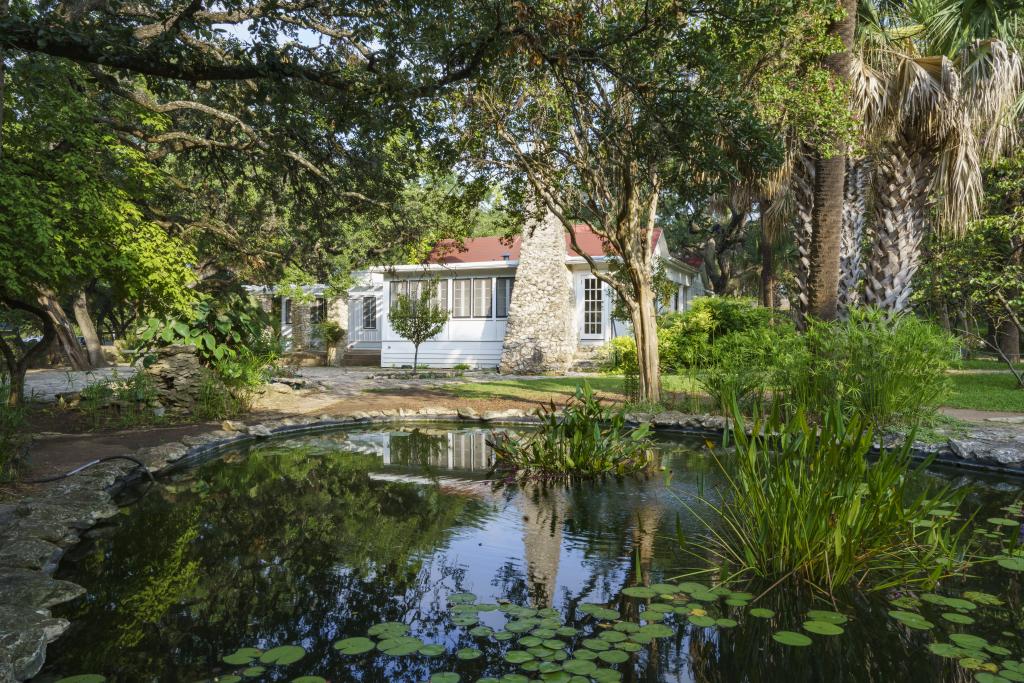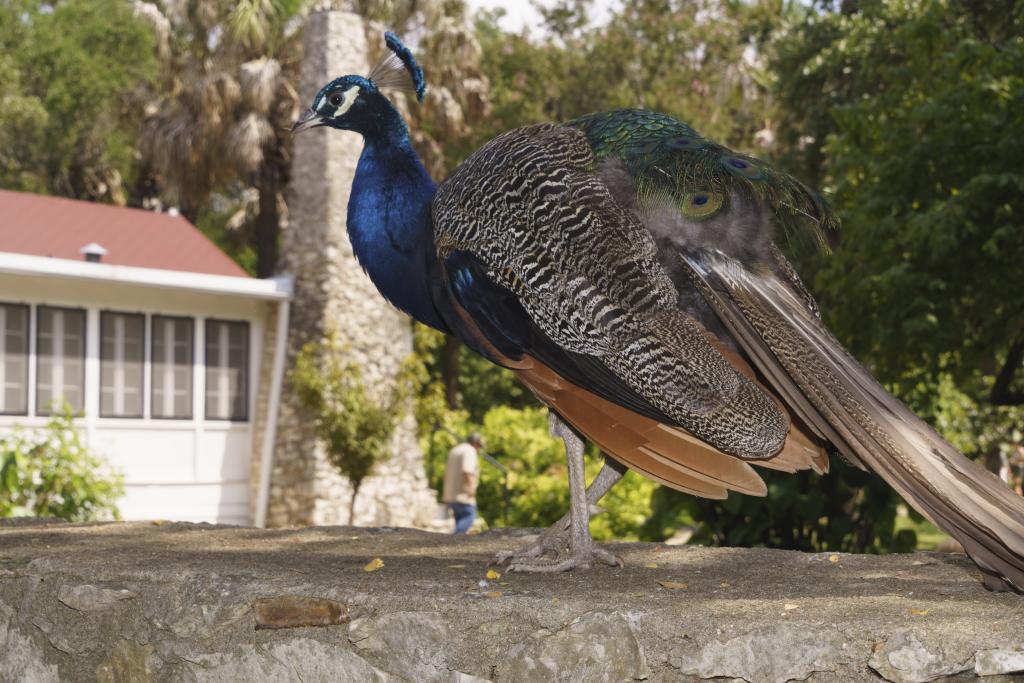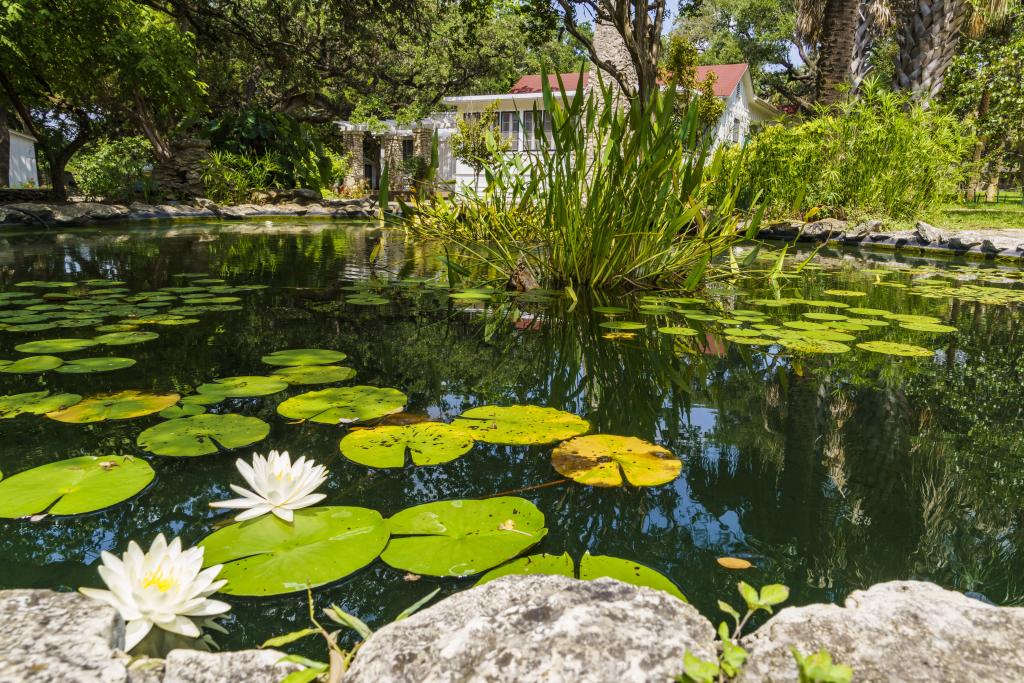
Stepping into Mayfield Park is not unlike stepping into an oasis. Towering palm trees, lush gardens and brilliant peacocks gather around the ponds, all of which is surrounded by a rock wall and the "desert" of a city beyond.
Mayfield is a metaphorical oasis, too. People from all walks of life visit the park as a respite from their busy days. Whether they are there to gather artistic inspiration, to be one with nature while doing yoga or just to get some quiet time from the office, visitors come to Mayfield to bask in its cool, calm and collected feel.
Virtual Tour Photo Gallery
-
- Garden Etiquette and Visits
-
The Gardens - The gardens may be visited inside the stone walls when not rented for an event. This is commonly most Mondays - Thursdays, and holiday weekends when the site is available.
NO events, commercial uses, classes or concessions are allowed on site without a permit from APARD.
- Pets are NOT allowed in Mayfield Park or Mayfield Preserve, please leave your pets at home.
- The gardens and paths are historic, varying surfaces from dirt, to grass, to cobblestone and sidewalk. Wear appropriate shoes for walking on uneven surfaces and watch your step.
- View and smell the flowers but leave them for others to enjoy. Stay on formal paths and out of flower beds.
- Each pond is a unique ecosystem. Specimens for study (i.e. tadpoles, water samples), should only be removed by adult program leader, then gently returned to their homes. Fishing is NOT allowed.
Peafowl Safety -
- The peafowl and their ancestors have lived at Mayfield for 70 years. This is their home. For your safety never approach, touch, or feed the peafowl or other wildlife.
- Please treat peafowl with respect and do not chase them.
The park's 23 acres boast a picturesque cottage available for wedding and event rentals, unique ponds covered in water lilies and the beautiful peacocks for which the park is known. Visitors of Mayfield may find the peacocks basking in the sun, roosting in the trees or simply strutting around the park. The sight of the birds and the sounds of their calls make visiting Mayfield Park an incredibly unique experience.
Learn more about reserving this facility.
Mayfield is home to a variety of other wildlife as well. Blue and green herons dot the trees while koi fish and turtles swim in the ponds beneath the water lilies. Palm trees - the largest stand of Sabal Texana palm trees north of the Rio Grande River - provide a shady respite from the summer sun. Walking paths twist through cottage gardens full of heritage plants maintained by community volunteers.
Volunteer gardeners receive help from the Mayfield Park / Community Project when choosing heritage plants for their gardens. Randomly mixed flowers provide year-round color, texture and fragrance to the 32 volunteer beds. The sweet aromas and bright colors of the flora planted in the gardens - along with the soft breeze and cool shade provided by the park's multitude of trees - lure visitors and volunteers alike to the area.
The cottage gardens, as well as the rest of Mayfield Park's features, are reminiscent of an earlier era. Austinites can look to Allison Mayfield and his daughter for the beginnings of this lovely oasis. Allison purchased the park's cottage and 23 acres for his family as a summer home in 1909. His daughter, Mary, and her husband, Milton Gutsch, moved into the cottage in 1922 and proceeded to add rooms to the house, design the gardens and build the stone walls, ponds and garden features. Mary Mayfield Gutsch died in 1971 and left the home and acreage to the City of Austin as a park.
Since then, the City's Parks and Recreation Department (PARD) has had tremendous support in maintaining Mayfield Park. Restoration of the cottage and gardens is coordinated by the Mayfield Park / Community Project, which has an agreement with PARD to facilitate improvements within the rock walls at Mayfield. The group works from a preservation master plan, and restoration proceeds as funds become available.
Austin's own Karen Cannatti has been active with the volunteer organization since it started receiving funds in 1986. She hopes the organization will continue to share Mayfield's impressive history with others. "Few people know the historical significance, which is an important part of the park," she explained. "Basically, because [the organization] developed a master plan, our purpose has been to restore the cottage and ponds to its original time...We like to say that we, all of us, are guests of the Gutschs."
Restoration efforts have been very successful thus far. According to Cannatti, members have "basically restored the house from roof to plumbing." All of the park's features, from the bright cottage to the colorful gardens, enable visitors to envision the area as it once existed - including its beloved peacocks. Cannatti said that the birds "were given to [the Mayfield-Gutsch family] as gifts in the 1930s." The peacocks of today's Mayfield Park descend from that first flock.
With all of its beauty and splendor, it is no surprise that so many volunteers and visitors regard Mayfield Park as an Austin oasis. When asked what she would say to attract others to the park, Cannetti replied, "You've got nature and trails. You have just beauty, quiet beauty. You have a historically significant bungalow-style cottage from the 1800s. You have the oldest extant gardens in this part of Austin. It's all historically significant, and it's peaceful...and a lot of people just come here for respite."






